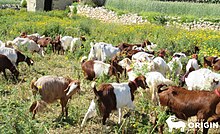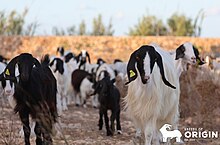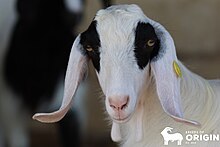Maltese goat
 An indigenous Maltese doe exhibited in Malta. | |
| Conservation status | International Transboundary Breed (2024): at risk[1] |
|---|---|
| Nicknames | Mogħża Maltija |
| Country of origin | Middle East[2] |
| Distribution |
|
| Use | Milk |
| Traits | |
| Skin colour | pinkish white or orange-red |
| Wool colour | white, grey, black, chestnut- red, brown or greyish white |
| Horn status | most are naturally polled (hornless) |
| Beard | usually no beard |
| Tassels | usually present |
| Notes | |
| usually long straight hair but may also be short | |
| |
The Maltese is a comparatively small sized rare breed of dairy goat known for its high milk production, high prolifacy and a resistance and adaptation to heat stress.[3]
Origin
[edit]This renowned dairy breed probably originated from the East and Central Mediterranean region, stretching to Asia Minor and the Middle East. As its name suggests, this breed takes its name from the island of Malta.[4]
History
[edit]Goats of the Maltese breed have been known in the Maltese islands for hundreds of years; with documented references published as early as the 19th century.

In 1886 the Maltese goat was already being showcased in the United Kingdom during a reunion for the colonial exposure of London.[5]
In the early 20th century the role of goats' milk in the transmission of Brucella melitensis in the Crown Colony of Malta became well known, and Maltese goats in particular were targeted. Stringent measures were adopted to identify and destroy all infected goats. Maltese goats which were positive for both milk and blood agglutination tests were destroyed.
In 1906 Maltese goatherds went on strike to prevent the authorities from sampling the milk for presence of the infective bacterium to avoid culling their goats. In some villages, 19% of all goats tested positive. In the same year a campaign was also launched against the use of raw goats' milk which lasted till 1916. By 1936 the consumption of un-boiled milk in shops had been prevented and by 1939 goatherds were also prohibited from selling fresh milk from door to door and from herding Maltese goats through the streets of Valletta and most towns.
In 1939 the Maltese goat population on the Maltese islands was estimated between 40,000 and 100,000 but numbers declined drastically by the end of World War II.[6] During these years of hardship, Maltese goats were forcefully slaughtered for consumption following severe food shortages.[7]
In 1956 an eradication program was launched to gradually replace goats' milk with cows' milk by exchanging goats for cows. The exchange was 11 goats for 1 imported dairy cow. This policy was later suspended in 1959.[8]
All these factors led to constant and rapid decline of the Maltese goat population in the Maltese islands.
Characteristics
[edit]The coat is usually long with straight hair but can also be short. Coat colour can be white, grey, black, light brown and reddish brown; and can be either plain, patchy, belted or with distinctive colour pattern distribution along the head and neck area. They are usually naturally polled, have a straight profile with ears ranging from horizontal or semi-pendulous to long lop with curled tips.[9]
Types
[edit]Considered an International Transboundary Breed, several sub-types of Maltese goats have emerged and tend to vary in different countries, namely:

- Maltese islands: The coat may be long or short; colours are usually chestnut-red or brown but can also be black, white, grey or pied. Coat patterns vary significantly from plain to either patchy/spotted to having a distinctively coloured head (sometimes to neck area), often with a facial stripe or blaze on the forehead. Ears are usually horizontal but may be lop with up-turned tips. Few specimens also have short erect ears.[10]
- Southern Italy, Sicily and Sardinia: This standardized type is referred locally as the Capra Maltese. The coat is typically long, straight and white (creamy) in colour, with raven-black areas on the head, neck and ears. Ears are usually semi-pendulous to long lop with curled tips.[11]
Use
[edit]The Maltese is a valued milk breed. The milk has pleasant taste without an excessively "goaty" odour or flavour.
In Malta, the most common practice nowadays is to use milk for the production of a variety of traditional cheeselets known locally as ġbejniet, irkotta and other goat cheeses.[12]
In Sicily, milk is used to make ricotta and traditional caprino cheeses including Padduni, which has PAT status.[13]
Population
[edit]
In Malta, the Maltese is the only indigenous goat breed. By 2024, the overall goat population in the Maltese islands has drastically fallen below 6,000 head with the population of the Maltese indigenous sub-type estimated to be less than 1,000 head as reported by Darryl Grech, Founder of Breeds of Origin Conservancy.[14] Additionally, the remaining Maltese goat population has been severely impacted by years of cross-breeding with other imported commercial breeds.[15]
In Italy, the Maltese is one of the eight autochthonous Italian goat breeds for which a genealogical herdbook is kept by the Associazione Nazionale della Pastorizia, the Italian national association of sheep and goat breeders. The herdbook was established in 1976. The Italian population of the Maltese breed was estimated in 1983 to be about 70,000, and in 2005 at 40,000. At the end of 2013 the registered population reported was 1,934.[16]
Conservation of the Indigenous Maltese goat of the Maltese islands
[edit]
In 2023, a non-profit organisation named Breeds of Origin Conservancy collaborated with a Maltese farm in Delimara known as Tulliera Farm Deli and imported 60 Maltese goats from Sicily to strengthen the genetic pool of the endangered indigenous Maltese goat population in Malta.[17]

In August 2024, Darryl Grech, Founder of Breeds of Origin Conservancy and President of the Maltese Goat and Sheep Co-operative Society, through a letter addressed to the Minister of Agriculture, Fisheries and Animal Rights, officially requested that the indigenous goat of the Maltese islands should be classified as a critically endangered 'Traditional Population' and the breed recognized as 'Local' and 'At-Risk'. This was done in an effort to safeguard the declining indigenous population.[18]
In September 2024, Breeds of Origin Conservancy officially launched the campaign 'Inħarsu l-Wirt Nazzjonali' with the aim to conserve and recognise endemic species and subspecies, indigenous livestock, and local agricultural cultivars and varieties as national heritage. The campaign's first target was to raise awareness about the decline of the indigenous goat of the Maltese islands with a traditional narrative ballad.[19]

On the 29th of September 2024, the first livestock show dedicated to the indigenous goats and sheep of the Maltese islands was held in Żejtun, Malta. This show was organised by Breeds of Origin Conservancy, in collaboration with the Koperattiva Maltija tal-Mogħoż u n-Nagħaġ (KMMN), Malta's Goat and Sheep Breeders Co-operative Society, in an effort to further highlight the need to safeguard the endangered traditional population of indigenous Maltese goats.[20]
References
[edit]- ^ "Imports 60 goats from Sicily to strengthen indigenous Maltese goats".
- ^ Blundell, R (1995). "Reintroduction of the local breeds of sheep and goats in Malta". Cahiers Options Méditerranéennes. 11: 97–100.
- ^ Attard, G. "METIC Agriculture: A résumé of identified themes for collaboration" (PDF).
- ^ TÖLÜ & SAVAŞ (2021). "An Important Genetic Material for the Turkish Goat Production: The Maltese Goat". Journal of Animal Science and Products. 4 (1): 112.
- ^ Attard, G. "METIC Agriculture: A résumé of identified themes for collaboration" (PDF).
- ^ Wyatt (2009). "Brucellosis and Maltese goats in the Mediterranean1" (PDF). Journal Of Maltese History. 1 (2): 4–18.
- ^ "When the British Empire waged war on the Maltese goat".
- ^ Attard, G. "METIC Agriculture: A résumé of identified themes for collaboration" (PDF).
- ^ TÖLÜ & SAVAŞ (2021). "An Important Genetic Material for The Turkish Goat Production: The Maltese Goat". Journal of Animal Science and Products. 4 (1): 112–113.
- ^ Grech, Darryl (2024). "An Overview of the Indigenous Goat of the Maltese Islands through various literature". Breeds of Origin Conservancy: 1–15. doi:10.13140/RG.2.2.28653.40161.
- ^ "Maltese – Italian Breeds of Goats".
- ^ "Amount of 'ġbejniet' to increase, but not everyone is happy".
- ^ "About Maltese Goats".
- ^ "Save the Maltese goat, breeders urge the government".
- ^ Coppola & Abela (2023). "A Preliminary Study on the Effect of Different Feeding Regimes on the Milk Chemical Composition of the Maltese Goat Breed During the Early Stage of Lactation". MCAST Journal of Applied Research & Practice. 7 (3): 123–137. doi:10.5604/01.3001.0054.2576.
- ^ "About Maltese Goats".
- ^ "Imports 60 goats from Sicily to strengthen indigenous Maltese goats".
- ^ "Request For The Indigenous Goat In Malta To Be Saved From Extinction".
- ^ "NGO launches campaign in a bid to recognise endemic species, indigenous livestock as national heritage". Newsbook Malta.
- ^ "1st Ever Show Dedicated To Maltese Indigenous Goats & Sheep".
